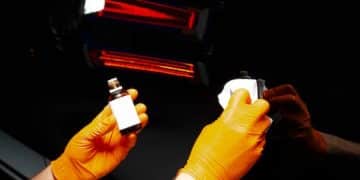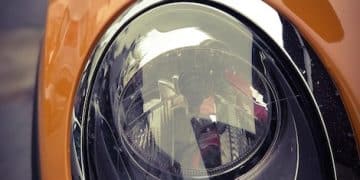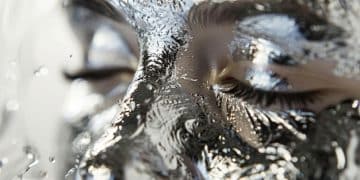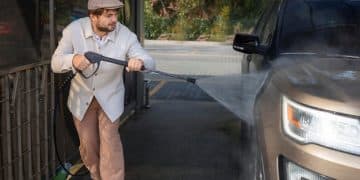The Best Ways to Remove Water Spots from Your Car’s Paint
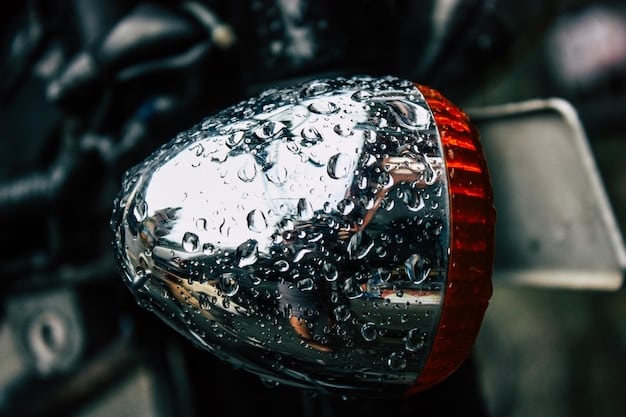
Removing water spots from your car’s paint involves identifying the type of water spot—hard or soft water—and using appropriate cleaning methods such as washing, polishing, or using specialized detailing products to restore the paint’s finish.
Are you tired of seeing unsightly water spots on your car’s paint? Those annoying marks can diminish your vehicle’s appearance and, if left untreated, potentially damage the clear coat. Discover the best ways to remove water spots from your car’s paint and keep your ride looking its best.
Understanding Water Spots and Their Impact
Water spots are more than just cosmetic blemishes; they are residues left behind when water evaporates from your car’s surface. Understanding what causes them and their potential long-term effects is crucial to properly addressing and preventing them.
Simply put, water spots come in two main forms: soft water spots and hard water spots. Soft water spots are usually easier to remove, consisting mostly of water minerals. Hard water spots, however, contain higher concentrations of minerals like calcium and magnesium, which can etch into the paint over time.
The Difference Between Soft and Hard Water Spots
Knowing the distinction between soft and hard water spots is key to employing the right removal techniques. Here’s a closer look:
- Soft Water Spots: These appear as light, dusty residues that can often be wiped away with a clean cloth or during a regular car wash. They are less aggressive and don’t typically cause permanent damage if addressed promptly.
- Hard Water Spots: These are the more stubborn culprits, often leaving noticeable rings or marks that adhere strongly to the paint. They require more intensive methods to remove, such as polishing or the use of specialized chemical solutions.
If water spots are left unattended for extended periods, particularly hard water spots, they can lead to significant damage. The minerals can penetrate the clear coat, causing etching that requires professional polishing or even paint correction to fix. Prevention is always better than cure, so regular maintenance is essential.
Essential Tools and Products for Water Spot Removal
Successfully removing water spots requires having the right tools and products at your disposal. These items will help you safely and effectively eliminate water spots without causing damage to your car’s paint.
Investing in quality products and tools ensures that you’re equipped to tackle water spots effectively while protecting your car’s finish. Here’s what you should consider:
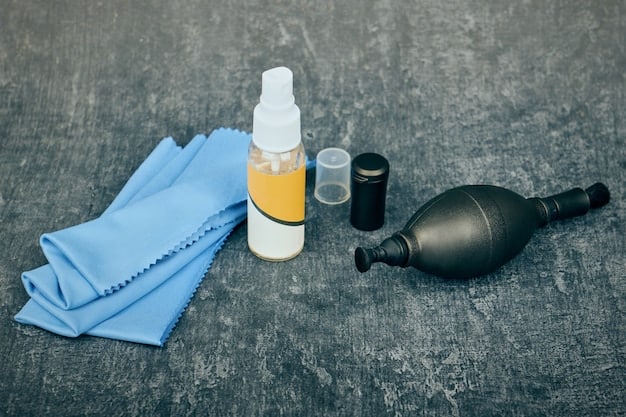
Must-Have Tools and Products
- pH-Neutral Car Wash Soap: A gentle yet effective cleaner is the foundation of any good car wash. pH-neutral soaps won’t strip away wax or sealant.
- Microfiber Towels: Essential for washing, drying, and applying detailing products. Choose high-quality towels to avoid scratching the paint.
- Detailing Spray: Ideal for removing light water spots and enhancing shine. Look for a product specifically designed for water spot removal.
Having these tools and products on hand will make the water spot removal process much smoother and more effective. Remember to always test products in an inconspicuous area first to ensure compatibility with your car’s paint.
The Gentle Approach: Washing and Detailing Spray
For light water spots, a gentle approach can be surprisingly effective. Regular washing combined with detailing spray can help remove water spots without resorting to more aggressive methods.
This method is best suited for fresh water spots that haven’t had time to bond strongly with the paint. Regular maintenance can prevent these light spots from becoming more problematic:
Step-by-Step: Washing and Using Detailing Spray
- Wash Your Car: Start with a thorough wash using pH-neutral car wash soap. This removes loose dirt and debris.
- Rinse Well: Ensure all soap residue is completely rinsed off.
- Dry with Microfiber Towel: Use a clean, soft microfiber towel to dry the car.
- Apply Detailing Spray: Spray a light mist of detailing spray over the affected area.
- Wipe Clean: Immediately wipe the area with another clean microfiber towel, using gentle pressure.
For those opting for a more targeted approach, consider utilizing a water spot remover. These products are formulated to dissolve mineral deposits effectively and can be found at most auto supply stores.
Level Up: Using Clay Bar for Stubborn Spots
When washing and detailing spray aren’t enough, a clay bar can be an effective next step. Clay bars gently lift contaminants and embedded water spots from the paint surface.
A clay bar is a resin-based compound that effectively removes bonded surface contaminants, including stubborn water spots. It’s a safe way to exfoliate the paint without causing scratches:
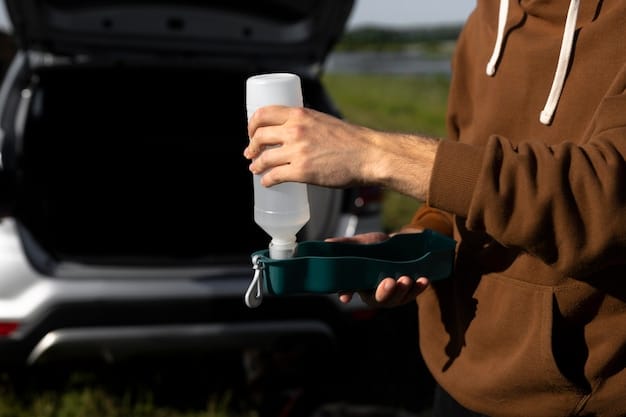
How to Use a Clay Bar Safely
- Wash Your Car: Start with a clean surface to avoid grinding dirt into the paint.
- Knead the Clay Bar: Flatten it into a patty shape.
- Lubricate: Spray clay bar lubricant generously over the area you’re working on.
- Glide the Clay Bar: Gently glide the clay bar back and forth over the lubricated surface.
- Wipe Clean: Wipe away any residue with a clean microfiber towel.
Always use proper lubrication to prevent the clay bar from scratching the paint. After using a clay bar, follow up with a wax or sealant to protect the freshly cleaned surface.
The Power Tool Approach: Polishing for Severe Water Spots
For severe, etched-in water spots, polishing is often the only effective solution. Polishing involves using a machine polisher and abrasive compounds to level the paint surface, removing the water spot damage.
Polishing should be considered when water spots have deeply penetrated the clear coat and cannot be removed by gentler methods. It’s a more aggressive approach that requires careful technique:
Polishing Techniques for Water Spot Removal
- Choose the Right Compound: Start with the least aggressive compound necessary to remove the water spots.
- Select the Appropriate Pad: Use a polishing pad designed for the compound you’ve chosen.
- Apply Compound to Pad: Follow the manufacturer’s instructions for applying the compound.
When polishing your car, it’s best to work in a controlled environment, such as a garage, away from direct sunlight. By carefully polishing with the proper tools, you can effectively remove even the most severe water spots, restoring your car’s paint to its original glory. Remember to apply wax or sealant after polishing.
Prevention: Keeping Water Spots at Bay
Preventing water spots is far easier than removing them. Simple habits and protective measures can significantly reduce the likelihood of water spots forming on your car’s paint.
Implementing a few preventative strategies can save you time and effort in the long run. These measures range from simple habits to more involved protective treatments:
Practical Tips for Preventing Water Spots
- Dry Your Car Immediately After Washing: Don’t let water air dry on the surface. Use a microfiber towel or a blower to dry it quickly.
- Park in Shaded Areas: Avoid parking in direct sunlight, as this accelerates water evaporation and mineral deposition.
- Apply Wax or Sealant Regularly: These products create a protective barrier that prevents water from bonding with the paint.
By adopting these preventive measures, you can minimize the occurrence of water spots and maintain your car’s flawless finish with less effort. Remember, consistent care is the key to a long-lasting, beautiful paint job.
Key Takeaways
Brief Overview
💧 Quick Removal
Address water spots promptly to prevent damage.
✨ Gentle Cleaning
Start with washing and detailing spray.
🔧 Clay Bar Use
Clay bar is effective for stubborn spots.
🛡️ Prevention
Regular waxing protects against water spots.
Frequently Asked Questions
▼
Water spots are caused by mineral deposits left behind when water evaporates from the car’s surface. These minerals can be from hard water, rain, or even car wash soap.
▼
While some household products might seem effective, it’s best to avoid them. They can be too harsh and damage the car’s paint. Instead, use products designed for auto detailing.
▼
Waxing your car every three to four months is a good practice. A good wax layer creates a protective barrier that prevents water and contaminants from directly contacting the paint.
▼
Polishing is generally safe, but it removes a thin layer of clear coat. It should not be done excessively. Always start with the least aggressive polish and pad combination.
▼
Yes, if left untreated, hard water spots can etch into the clear coat, leading to permanent damage. Regular maintenance and prompt removal are key to preventing this.
Conclusion
Removing water spots from your car’s paint doesn’t have to be a daunting task. By understanding the types of water spots, using the right tools and techniques, and adopting preventive measures, you can maintain a flawless and gleaming finish. Whether it’s a simple wash and detailing spray or a more involved polishing process, keeping your car free of water spots enhances its appearance and protects its value.
